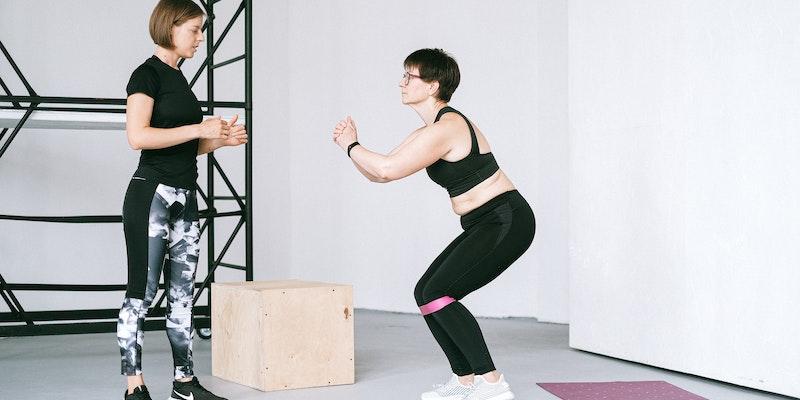Few people recognize that squats may aid with weight reduction, stamina, strength, and power. Their simplicity makes them appealing to all fitness levels. Squats benefit everyone, from beginners to experts. Yet, properly squat exercises appear easy and offers many advantages, but doing them improperly can be dangerous. Bad technique can cause many long-term injuries, but knee and back problems are most prevalent.
Tips to Do Perfect Squat
Squats train several muscle groups and strengthen and stabilize you, making them essential to any workout routine. However obtaining the appropriate posture is crucial for maximizing squats and minimizing danger. The squat form varies by body shape and taste, but there are some fundamental criteria to help you do it properly.
Let's examine the proper squat form most crucial points and why:
Knee Alignment
A safe and successful squat requires proper knee alignment. Squat with your knees aligned with your toes. Avoid letting them sink or protrude over your toes. Accurate alignment reduces knee stress.
Hip Hinge
Imagine sitting on a chair to commence a squat. Push your hips back as much as your knees. Hip hinges strengthen the glutes and align the spine and pelvis. This is crucial for squatting with the proper muscles.
Depth
Squatting depth matters. Drop on the ground with knees and hips bent. Descend further if feasible. Overbending your lower back and going shallow might damage your muscles. Correct depth is essential for safe squatting.
Spine Alignment
Squatting with a straight back prevents accidents. Always keep your back straight when moving. Avoid rounding or arching your back to avoid pain and strain. A stable spine supports and reduces injury risk.
Weight Distribution
Make sure your feet sustain the same amount of weight. Avoid stressing your toes or shoes. A balanced spread reduces the risk of tripping or losing form while squatting.
Safety Warnings
If you're new to squats, practice with a trainer or workout specialist. They may give you tips, enhance your skills, and prevent injury.
Common Mistakes To Avoid
These are some common mistakes people make when doing squats properly. Know them to avoid them during a proper squat.
Do Not Skip Warm-up

Skipping a warm-up before squatting can be dangerous. Warm-ups are essential to any decent workout but are especially important for proper squat form. These are the reasons why they matter:
Increase Blood Flow
Warming up isn't just a routine; it's crucial to preparation. It increases blood flow to your muscles. This boosts your body temperature, which is essential for peak performance.
Increase Joint Mobility
Squats need numerous joints to operate smoothly. A proper warm-up moves these joints to make them more flexible and less prone to ache during squats.
Maximize Muscular Activation
Warming up isn't enough—you need to wake up your muscles. Squats are better with a well-planned warm-up that prepares vital muscle groups.
Try RAMP, an abbreviation that summarizes together the major warm-up principles, to improve your proper squat form:
- R: Start your warm-up with light exercise or brisk walking to raise your heart rate and body warmth.
- A: Focus on squatting muscles. Strength-building workouts include leg swings, glute bridges, and barefoot squats.
- M: Check your joints' mobility. This is crucial for squats requiring fluid leg, knee, and hip movement.
- P: Exercise for a brief time at 10% energy. This might entail completing a few squats with your weight before the workout.
Adding RAMP to your warm-up will help you squat better and avoid muscle and joint pain. Warming up isn't just for show—it's essential to greater squatting.
Don't Start With Your Buttocks
Squats strengthen the legs and lower body. Thus, many workouts incorporate them. The "Butt-first" approach is a typical blunder that might injure you. You must know how to properly squat correctly to maximize advantages with little danger. Squatting should start with knees bent, not buttocks up. Leading with your butt strains your legs and back. Abuse can bring long-term anguish.
Wrong Muscles
Squats engage your hips and quadriceps, which are front-thigh muscles. Starting with your buttocks may work your legs and lower back, which isn't the goal.
Safety
The "butt-first" strategy might increase your risk of pulling your leg when using heavy gym equipment in fitness facilities. Worse, a torn muscle might force you to lose control and drop weights, hurting you.
Start by bending your knees for safe squats. Your back should be straight, your knees should match your feet, and your core should be taut. Squats work your legs and lower body and reduce injury risk if done correctly. Remember that the appropriate strategy is the most incredible way to get fit and avoid injury.
Watch Your Knees
Remember not to allow your knees to cross over your toes when squatting. This simple guideline maintains doing squats properly, forms, and reduces knee stress. Activities that put your knees past your toes might cause discomfort or injury. Keep your knees in line with or behind your toes to complete them securely when squatting.
Squatting with your knees is essential because:
- Squatting with your knees in line with your toes keeps your body balanced. This stance prevents unusual, strain-inducing curves and eases knee tension.
- Excessive knee movement can strain the knee joint and cause discomfort or damage. Maintaining proper knee alignment reduces this danger and makes sitting safer.
Change your balance and squat level to optimize your knees and toes. You may adapt your squatting style to your demands and body type while maintaining your knees straight.
Do not Do Partial Squats

Never perform a half-squat. Always do a complete one. This seemingly easy technique will maximize this activity and reduce your chance of injury.
Squatting should include the whole range of motion for many reasons. Squats train several muscular groups, strengthen the lower body, and enhance fitness. You must properly squat to feel these results. Put your legs flat on the ground to perform this. Partial squats shorten the action, preventing injury. This might cause uneven muscle development and joint tension. Full squats activate all muscles simultaneously and reduce injury risk when done correctly.
A complete squat may be impossible due to femur length or head angle, but most people can accomplish it with considerable effort. Your squat technique must match your physique. Complete range of motion is the most excellent method to maximize exercise and safeguard your health. When you squat, remember wide squats for full benefits and safe activity.




